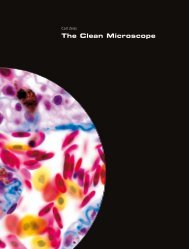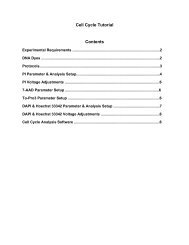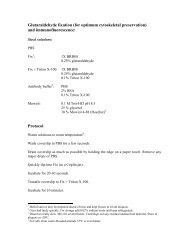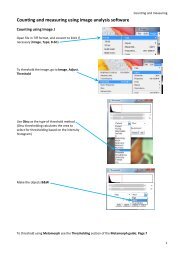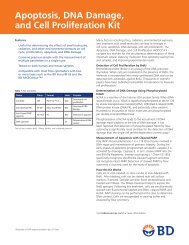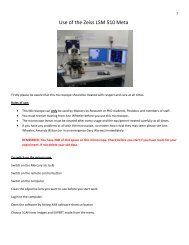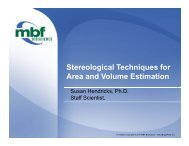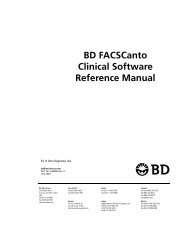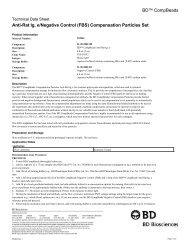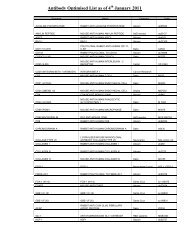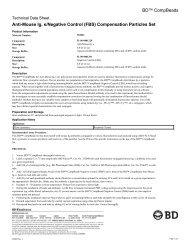BD™ Phosflow Alexa Fluor® 647 Rat anti-Histone H3 (pS28)
BD™ Phosflow Alexa Fluor® 647 Rat anti-Histone H3 (pS28)
BD™ Phosflow Alexa Fluor® 647 Rat anti-Histone H3 (pS28)
You also want an ePaper? Increase the reach of your titles
YUMPU automatically turns print PDFs into web optimized ePapers that Google loves.
4. Stain the cells with 20 μl <strong>Alexa</strong> <strong>Fluor®</strong> <strong>647</strong> <strong>Rat</strong> <strong>anti</strong>-<strong>Histone</strong> <strong>H3</strong> (<strong>pS28</strong>) in 80 μl stain buffer for 20 minutes at room temperature, then wash<br />
them with stain buffer.<br />
5. For optimum cell cycle analysis, the cells should be treated with RNAse before staining with propidium iodide:<br />
• Treat the stained cells with 50 μg RNAse A (Sigma R5500) in 50 μl 1X PBS for 30 minutes at 37°C. Without washing, stain DNA by<br />
adding 5 μg Propidium Iodide (Sigma P4170) in 450 μl staining buffer for at least 10 minutes at room temperature.<br />
Or<br />
• Stain the cells with 0.5 ml PI/RNase Staining Buffer (Cat. No. 550825) for 15 minutes at room temperature.<br />
6. The cells are now ready for flow cytometric analysis.<br />
Suggested Companion Products<br />
Catalog Number Name Size Clone<br />
554656 Stain Buffer (FBS) 500 ml (none)<br />
550825 PI/RNase Staining Buffer 100 ml (none)<br />
Product Notices<br />
1. This reagent has been pre-diluted for use at the recommended Volume per Test. We typically use 1 × 10^6 cells in a 100-µl experimental<br />
sample (a test).<br />
2. Please refer to www.bdbiosciences.com/pharmingen/protocols for technical protocols.<br />
3. Since applications vary, each investigator should titrate the reagent to obtain optimal results.<br />
4. This product is sold under license from Shigei Medical Research Institute, Okayama, Japan.<br />
5. <strong>Alexa</strong> <strong>Fluor®</strong> <strong>647</strong> fluorochrome emission is collected at the same instrument settings as for allophycocyanin (APC).<br />
6. For fluorochrome spectra and suitable instrument settings, please refer to our Fluorochrome Web Page at www.bdbiosciences.com/colors.<br />
7. Caution: Sodium azide yields highly toxic hydrazoic acid under acidic conditions. Dilute azide compounds in running water before<br />
discarding to avoid accumulation of potentially explosive deposits in plumbing.<br />
8. Source of all serum proteins is from USDA inspected abattoirs located in the United States.<br />
9. <strong>Alexa</strong> Fluor is a registered trademark of Molecular Probes, Inc., Eugene, OR.<br />
10. The <strong>Alexa</strong> <strong>Fluor®</strong>, Pacific Blue, and Cascade Blue® dye <strong>anti</strong>body conjugates in this product are sold under license from Molecular<br />
Probes, Inc. for research use only, excluding use in combination with microarrays, or as analyte specific reagents. The <strong>Alexa</strong> <strong>Fluor®</strong> dyes<br />
(except for <strong>Alexa</strong> <strong>Fluor®</strong> 430), Pacific Blue dye, and Cascade Blue® dye are covered by pending and issued patents.<br />
References<br />
Carmena M, Earnshaw WC. The cellular geography of aurora kinases. Nat Rev Mol Cell Biol. 2003; 4:842-854.(Biology)<br />
Cheung P, Allis CD, Sassone-Corsi P. Signaling to chromatin through histone modifications. Cell. 2000; 103:263-271.(Biology)<br />
Choi HS, Choi BY, Cho Y-Y, Zhu F, Bode AM, Dong Z. Phosphorylation of Ser28 in histone <strong>H3</strong> mediated by mixed lineage kinase-like mitogen-activated protein<br />
triple kinase α. J Biol Chem. 2005; 280(14):13545-13553.(Biology)<br />
Dyson MH, Thomson S, Inagaki M, et al. MAP kinase-mediated phosphorylation of distinct pools of histone <strong>H3</strong> at S10 or S28 via mitogen- and stress-activated<br />
kinase 1/2. J Cell Sci. 2005; 118(10):2247-2259.(Clone-specific)<br />
Furukawa K, Sugiyama S, Osouda S, et al. Barrier-to-autointegration factor plays crucial roles in cell cycle progression and nuclear organization in Drosophila. J<br />
Cell Sci. 2003; 116(18):3811-3823.(Clone-specific)<br />
Goto H, Tomono Y, Ajiro K, et al. Identification of a novel phosphorylation site on histone <strong>H3</strong> coupled with mitotic chromosome condensation. J Biol Chem. 1999;<br />
274(36):25543-25549.(Immunogen)<br />
Hirata A, Inada K, Tsukamoto T, et al. Characterization of a monoclonal <strong>anti</strong>body, HTA28, recognizing a histone <strong>H3</strong> phosphorylation site as a useful marker of<br />
M-phase cells. J Histochem Cytochem. 2004; 52(11):1503-1509.(Clone-specific)<br />
Nowak SJ, Corces VG. Phosphorylation of histone <strong>H3</strong>: a balancing act between chromosome condensation and transcriptional activation. Trends Genet. 2004;<br />
20(4):214-220.(Biology)<br />
Pascreau G, Arlot-Bonnemains Y, Prigent C. Phosphorylation of histone and histone-like proteins by aurora kinases during mitosis. Prog Cell Cycle Res. 2003;<br />
5:369-374.(Biology)<br />
558217 Rev. 5 Page 2 of 2





